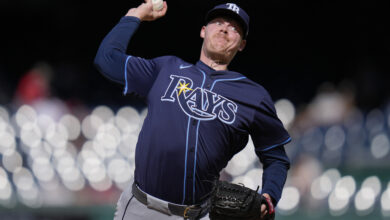
Cubs Offense Great Against Rangers, Still Too Early to Say It’s Gone from Broke to Woke
The one bright spot in the Cubs’ opening series against the Rangers was the offense. They finished the three-game set with the second-highest OPS (1.003) and the second-most runs per game (9.3) in the National League. However, pronouncements that their performance at the plate had gone from broke to woke remain entirely premature.
I am not even talking about obvious caveats about small sample sizes. Recognizing that the Rangers’ staff is hardly representative of elite major league pitching is a step in the right direction. Texas had the third-highest ERA in the American League last year, but even this doesn’t adequately capture the aspect that may have most benefited the Cubs: scant few power arms (more context here).
Though good pitchers will stifle just about any team, power arms have served as an especially troublesome Achilles heel of the Cubs offense the last two years. Last year, only contact-hitting Ben Zobrist (.330), Jason Heyward (.317) and Albert Almora Jr. (.286) hit power arms at a .270 or higher clip. Meanwhile, most the rest of lineup struggled woefully. This includes Kyle Schwarber (.215), Ian Happ (.212), Javier Báez (.212), Addison Russell (.198) and Willson Contreras (.147).
Take Báez, for example, whose great overall 2018 performance had him in the MVP hunt all season. Against power arms, however, his value deflated with the rest of the lineup. When you dive into his numbers, you see a power hitter with incredible bat speed. However, the loading required to generate that power generate hurts him against velocity 95 mph or higher.
Jason Heyward’s 2018 offers no comparison to Báez’s, right? Their disparate stats say as much, and yet Heyward’s quick, high-contact swing made him far more dangerous than Báez against power pitchers. Beyond a batting average more than 100 points higher, three of Heyward’s eight homers came on fastballs ranging from 96-99 mph. By comparison, only two of Baez’s 34 came on pitches over 94 mph.
The lesson here is you don’t need insane bat speed to drive a ball far when the pitcher is supplying a good deal of the energy. You just have to be quick enough to square it up, and then let all that velocity transfer to the barrel of your bat.
Heyward’s taters also came off some impressive names: Corey Knebel of the Brewers (96 mph); Phillies lefty Adam Morgan (a 97 mph walk-off grand slam); and Cardinals flame-thrower Jordan Hicks (99 mph). By comparison, Báez’s homers against high velocity came versus less heralded hurlers Gerson Bautista of the Pirates (99 mph) and Jimmy Cordero of Washington (97 mph). Perhaps because their fastballs have little movement, neither started the season on their team’s Opening Day roster.
For these reasons, some wait-and-see is in order for the Cubs’ order. Underscoring this, the Cubs racked up the second-fewest plate appearances against power arms per game of any team in the majors (4.3). From their 13 plate appearances thus far, they have generated one walk and just one hit (a bunt against the shift by Kyle Schwarber) for a major league-worst .083 average.
But the sample size will increase sharply against the Braves, who feature a pitching staff largely filled with high-K pitchers. In Monday’s game, Baseball Reference counted 34 of the Cubs’ 37 plate appearances as coming against a power pitcher (defined by that site as in the upper third of the league for strikeout plus walks).
The Cubs did rack up nine hits – which elevated their batting average to .238 – but no runs. This leaves them as one of only two teams in the majors yet to score against this particular call of pitchers. The Padres are the other.
But this is far from a pronouncement of impending doom. Like with most hopes for this year’s offense, a full season with a healthy Kris Bryant should help. Before injuring his shoulder last year, he was hitting .286 with a 1.031 OPS against power arms. This came after a .289 average in 2017. And Anthony Rizzo’s .266 average last year was 50 points higher than his career rate.
There is also hope for additional growth from Báez, who displayed an improved ability to lay off outside sliders during the Rangers series. This was something he did not do in 2018 when he simply hit everything he could reach a lot harder. Combine this with a better eye and maybe he comes closer to Joe Maddon’s comparison to Manny Ramirez.
Of course, the Rangers pitchers don’t represent the best of the best, and getting nine hits in a game without scoring a run against the Braves is unusual. So I’m interested to see how well the Cubs fare against the hard throwers of Atlanta and Milwaukee. That will give us our best snapshot of whether the offense that broke last year is truly on the mending itself from within.

